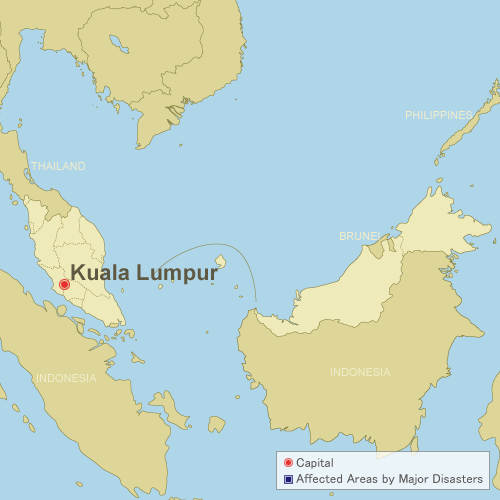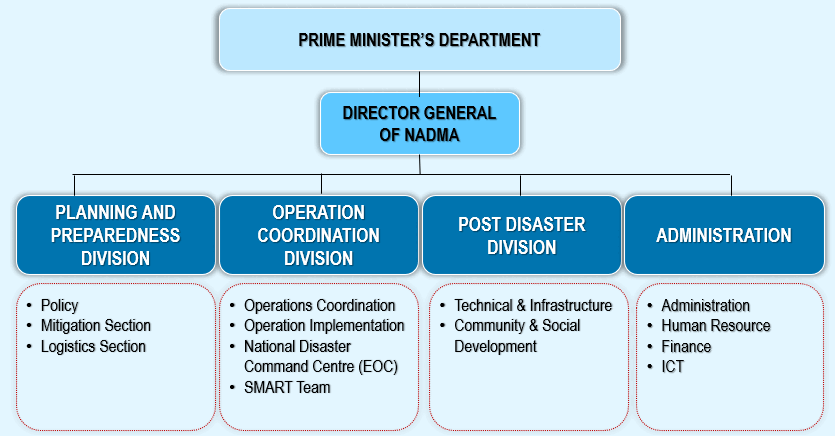TOP PAGE > Information on Disaster Risk Reduction of the Member Countries
Information on Disaster Risk Reduction of the Member Countries
 マレーシア
マレーシア
General Information
 Formal Name: Malaysia
Formal Name: MalaysiaMalaysia is located in Southeast Asia and is divided into two regions: Peninsular Malaysia (West Malaysia) and East Malaysia, located on the island of Borneo. Malaysia is a federal constitutional monarchy consisting of thirteen states and three federal territories. The country is known for its cultural diversity, with a varied ethnic makeup that includes Malays, Chinese, Indians, and indigenous tribes, totalling 80 distinct ethnic groups.
Out of the current population of 34.1 million, the main ethnic groups include Bumiputera (Malays, Orang Asli—indigenous peoples—and natives of Sabah and Sarawak), Chinese, Indians, and others. Non-citizens number approximately 2.69 million. The official language is Bahasa Malaysia, and Islam is the official religion.
In terms of its economic profile, Malaysia has a diverse, driven by industries such as manufacturing, agriculture, services, and natural resources. Key sectors include palm oil, rubber, timber, oil and gas, electronics, automotive, and tourism.
Overview of Disasters
Malaysia lies outside the "Ring of Fire" and is not typically in the path of tropical cyclones, meaning it faces a lower risk of earthquakes and direct cyclone impacts. However, these events can still occur occasionally. The country is more often affected by floods, landslides, storms and heatwaves. Among these, floods are the most common disaster.
Recent Major Disasters
Landslide (December 2022)
A landslide occurred at 2:08 a.m. on 16 December 2022, affecting an agricultural area and campsite at Father’s Organic Farm in Batang Kali, Hulu Selangor, Selangor. The incident destroyed almost the entire campsite and farming area, resulting in 92 victims, including 31 fatalities—13 of whom were children—and 61 survivors. The search and rescue (SAR) operation was launched immediately and continued for nine days, concluding after the last victim was found.
Flood (December 2021)
The floods of December 2021, which occurred over six episodes of monsoon surges, served as a wake-up call to prioritize prevention and mitigation, rather than focusing solely on disaster response. Two major series of monsoon floods struck: one from 17 to 20 December 2021, and another from 25 February, affecting both the western and eastern parts of Peninsular Malaysia.
The 17 December event was particularly devastating in the state of Selangor, where the scale of the disaster was unprecedented in an urban area. A total of 58 casualties were recorded, marking the highest mortality in Malaysia's history due to flooding. Approximately 400,000 people were displaced, and the overall financial losses were estimated at RM6.1 billion, affecting residential areas, public assets and infrastructure, vehicles, manufacturing, business premises, and agriculture.
Yellow Flood (December 2014)
In December 2014, Malaysia experienced its worst monsoon flood in history, affecting several states, with Kelantan being the worst-hit. According to data from the Department of Welfare, 541,896 people were affected nationwide, and the Government incurred RM2.58 billion in losses to public infrastructure alone. The flood presented the greatest challenge for the Government due to the sheer number of victims and the scale of the flooding, which hindered rescue and relief efforts while also causing extensive damage to infrastructure.
Disaster Management System
Legal System
The National Security Council (NSC) Directive No. 20 promulgated in 1997 states the mechanism on the management of disasters including the responsibilities and functions of the various agencies under an integrated emergency management system.
The Land Conservation Act, Environmental Quality Act (1974), and the Local Government Act (1976) and the Road, Drainage and Building Act also refer to disaster management.
The Land Conservation Act, Environmental Quality Act (1974), and the Local Government Act (1976) and the Road, Drainage and Building Act also refer to disaster management.
Organization
 Following the large-scale flooding event in 2014 and the 5.9 magnitude earthquake in Ranau, Sabah, on June 5, 2015, which tragically claimed the lives of 18 mountain climbers on Mount Kinabalu, the Government of Malaysia embarked on transforming and strengthening its disaster management structure and mechanisms. On August 26, 2015, the Cabinet approved the establishment of the National Disaster Management Agency (NADMA) under the Prime Minister’s Department, which took over responsibility from the National Security Council. NADMA has been operational since October 1, 2015, and serves as Malaysia’s new focal point for disaster management at both the regional and international levels. Through NADMA, the government envisions creating a more resilient nation and society by implementing a sustainable disaster management framework that covers policies, programs, and projects before, during, and after disasters.
Following the large-scale flooding event in 2014 and the 5.9 magnitude earthquake in Ranau, Sabah, on June 5, 2015, which tragically claimed the lives of 18 mountain climbers on Mount Kinabalu, the Government of Malaysia embarked on transforming and strengthening its disaster management structure and mechanisms. On August 26, 2015, the Cabinet approved the establishment of the National Disaster Management Agency (NADMA) under the Prime Minister’s Department, which took over responsibility from the National Security Council. NADMA has been operational since October 1, 2015, and serves as Malaysia’s new focal point for disaster management at both the regional and international levels. Through NADMA, the government envisions creating a more resilient nation and society by implementing a sustainable disaster management framework that covers policies, programs, and projects before, during, and after disasters. Plan
The National Disaster Risk Reduction Policy 2030 will be the primary reference point for disaster risk management guidance at the national, local, and across sectors.
ADRC Counterpart
Country Report
Country Report 2024 (English Version, PDF file)Country Report 2018 (English Version, PDF file)
Country Report 2011 (English Version, PDF file)
Country Report 2009 (English Version, PDF file)
Country Report 2008 (English Version, PDF file)
Country Report 2006 (Japanese Version, PDF file)
Country Report 2006 (English Version, PDF file)
Country Report 2003 (English Version, PDF file)
Country Report 1999 (English Version, PDF file)
Country Report 1999 (Japanese Version, PDF file)
Country Report 1998 (English Version, PDF file)

